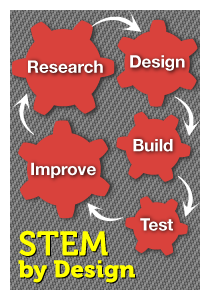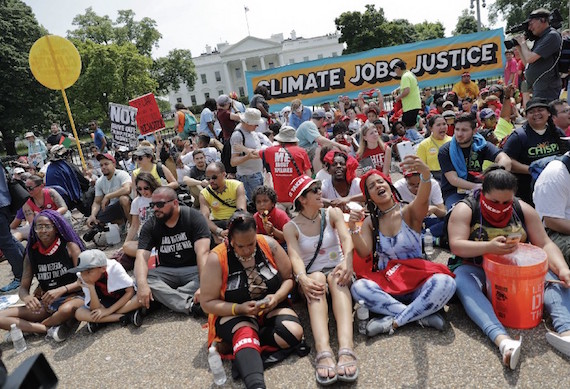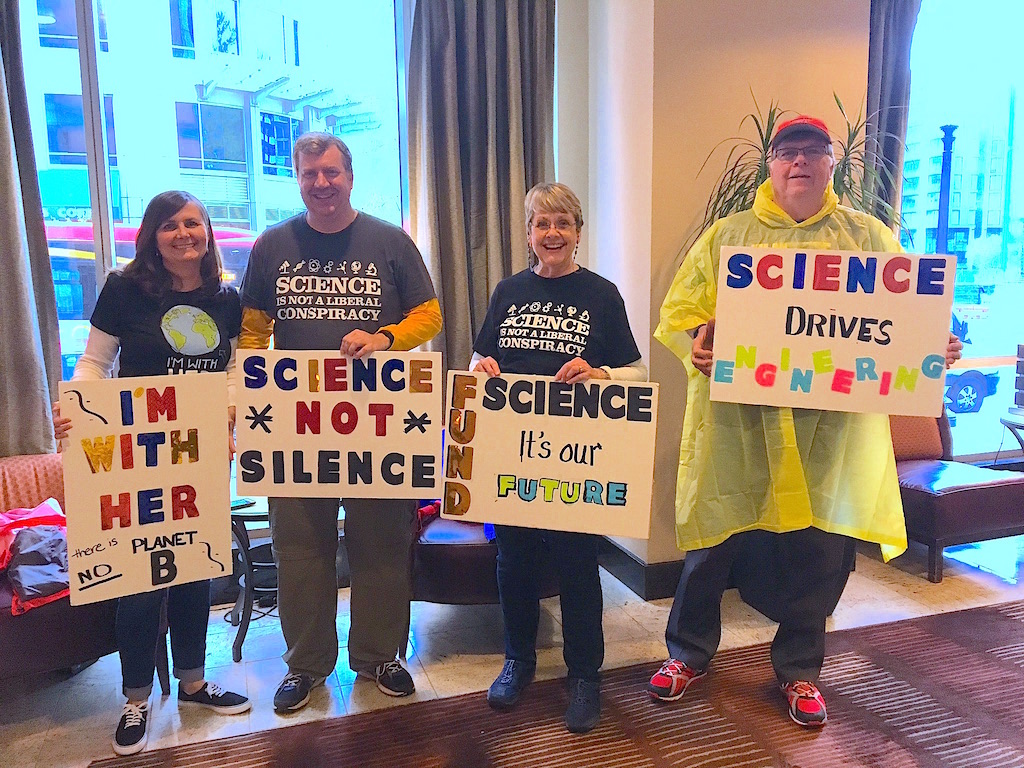Why I Marched for Science on Earth Day
A MiddleWeb Blog
 On April 22 (Earth Day) I grabbed my homemade sign, pulled on my March for Science t-shirt, and joined 150,000 colleagues in Washington D.C. in the March for Science.
On April 22 (Earth Day) I grabbed my homemade sign, pulled on my March for Science t-shirt, and joined 150,000 colleagues in Washington D.C. in the March for Science.
Why are you doing that? incredulous friends and neighbors here in Alabama wanted to know. So I’m explaining here why I traveled 750 miles and stood/marched for hours in a chilly rain. And why I feel good about doing that.
The beginning
In the late 1990s I served on a state science textbook adoption committee. As I dutifully poured over book after book, I was flooded with flyers, faxes, and emails about the “outrageous facts” these textbooks contained. I naturally checked out this information and discovered that many of the so-called “facts” they cited were actually the wrong answers to multiple-choice questions in the books.
Others were total misinterpretations of sentences taken out of context. I naively thought that if I pointed this out to the organization perpetrating this bizarre barrage, its leaders would at least be chagrined. Ha! I learned that this was their method of doing business. And that experience marked my first encounter with a deliberate “alternative facts” campaign aimed at science.
Anne Jolly (3rd fr left) and her family, well prepared for marching in inclement weather!
Today alternative facts still loom large. Science remains tangled up in cultural and political battles, and the lack of science literacy leads to flawed policy making. This year’s March for Science gave me a venue to express my growing exasperation with people who – rather than examining evidence to make reasonable decisions – simply attack any science that doesn’t support their ideology or political orientation.
The now
The real tipping point that launched me into the midst of the March for Science, however, came when this “let’s-just-ignore-the-science” epidemic began to infect the national budget. The proposed staggering funding cuts to science research and science education read like a horror story to me. They threaten STEM education and careers.
Take a look at some of these proposed cuts:
NASA: The budget proposal eliminates the NASA Education Office, which focuses on K–12 education outreach, free teaching resources, scholarships, fellowships, and grants. I used this service every single year during my teaching career. Through these programs NASA helps to train our next generation of STEM workers – scientists, engineers, educators, and astronauts.
I agree with New York high school teacher Gene Gordon who says: “These programs are giving [students] life skills and skills to succeed in their careers and in their futures, even if they don’t go into a STEM field.”
NASA’s Earth science programs are also targeted for a budget cut. This makes me, as a former earth-science teacher, join in to send out a red alert. Almost all the cuts target climate change research and exploration. Regardless of ideology, we at the very least need to know what evidence science is turning up about the human contribution to environmental problems. We need to know how to nurture and protect our home planet.
NOAA: Earth science takes another serious hit in the proposed cuts to NOAA. The Sea Grant programs lead list of cuts there. These grants and programs support coastal and marine management, research, and education. The Dauphin Island Sea Lab is one example of a Sea Grant facility instrumental in continuing to educate me, and in giving my students hands-on, real life experiences. Through our interactions with NOAA-funded programs, my students discovered real problems and needs that they might one day be part of solving.
The DOE: At the Department of Energy, funding for clean energy projects and fuel-efficient cars is on the chopping block, along with the Energy Star (a program that sets standards for energy-efficient appliances) and the Superfund program that cleans up toxic and hazardous waste sites. The DOE Office of Science – responsible for fusion energy research – is also in the bullseye for cuts. For our students, the need to develop clean, safe, and efficient sources of energy will be one of the biggest issues in their lifetimes.
The NIH: Perhaps most shocking were the proposed deep cuts to the National Institutes for Health. This organization funds disease research at universities and hospitals and carries out its own medical research programs. One cancer researcher told Nature they were especially worried about funding for multi-year epidemiology studies at the NIH’s cancer institute, where even short interruptions can hinder a study. The Fogarty International Center has been targeted for complete elimination. This Center’s mission is global health – training scientists in developing countries. Disease (science tells us) is no respecter of national borders.
The EPA: No surprise here. As Nature reported, the biggest swing of the budget axe – across the entire budget plan – is aimed at the EPA. The 31% cut to the EPA guts some programs focused on air, climate, and energy research; safe and sustainable water resources; human health risk assessment; sustainable and healthy communities; and Homeland Security research. Those cuts alone would eliminate approximately 3,200 jobs – most of them STEM related. A number of proposed budget cuts threaten the National Parks as well.
Other proposals for science agency cuts are yet to be revealed. In the meantime, funding for the Corporation for Public Broadcasting, the National Endowment for the Arts, and the National Endowment for the Humanities (a tiny portion of the federal budget) is eliminated in the proposed budget.
The Impact
Those are not all the proposed funding cuts, but you can see why this science teacher put on my marching shoes. My students wanted to make their world a better place. They were especially interested in solving health, energy, and environmental problems. Their hearts were big and their dreams were big. And I want this nation to be a place that welcomes people like that.
How much important STEM work – aimed at solving some of our earth’s environmental, medical, and energy problems – will be stopped or stymied by cuts to science and rejection of science-based policies? What impact will the dismissive attitude toward science have on our society and future political focus?
The March for Science was billed as a non-partisan affair. For the most part that was the case. We need to depoliticize science, and we need to reject anti-scientific ways of thinking that ignore what we know and can prove about the natural world.
I was inspired by the passion of my colleagues during this march. I was engaged by the spirit and the positive energy. And I plan to remain involved in science advocacy…
✻ Through advocating and promoting STEM, and designing STEM resources.
✻ Through maintaining membership in various science organizations.
✻ Through subscribing to and reading science publications, and staying up to date in my field.
✻ Through speaking up on behalf of science and STEM – which have designed the world around me.
✻ Through putting on my marching shoes when the need arises!

By the time you read this post, thousands of caring citizens will have also joined in the Climate March in Washington and other cities. Plenty of dissenters will be there too. (Here’s a New York Times report). If you want to take a look at some of the data, here’s the 2015 State of the Climate report from the American Meteorological Society (AMS, supported by NOAA). A more accessible “highlights” version was produced for the 2009 report, so I’d recommend that as well. (I had originally intended to provide a link to climate change evidence at the EPA website, but that information has been removed very recently.)
Scientific debate is a good thing. It’s really at the heart of scientific research and science education. Science teachers across America and the world would agree, I think. That’s what I’m advocating: Science Not Silence!































Bravo Anne! You said with utmost clarity what needs to be said and why. Science is not partisan and must not be, it is for everyone’s benefit. At the same time, it is political as those who create and advocate for policy must be informed by truth. Thank you and keep talking!
Thanks, Ruth! I appreciate your support for science as well as for your real passion – art. Here’s hoping that the NEA will not be eliminated as the budget called for originally. Some things are precious to the culture and technology of this nation.
Right with you Anne! You articulated many of the reasons why I marched in Austin on Earth Day. I also marched with my kids- who all love science (of course!) so that they could see the large numbers and great cross section of society who value scientific thought and progress. Thank you!
So glad you are teaching your kids to stand up and take note of what’s happening and how they can help to improve their world. Keep teaching them to value critical thinking and progress. That’s a much-needed talent!
Wondering about the “neutral” part of the Science March. It seems the alternate facts flow both ways. For example, I didn’t hear any mention of the fact that nuclear power is perhaps the most effective way of greening the planet. But it is politically unpopular.
We owe it to our students to be honest in presenting scientific fact. Research in solar, wind and other energies is fine. Let’s at least admit that we are choosing to ignore some science.
Hi, Willis, are you referring to the Climate March on April 29? I was marching in and writing about the March for Science on April 22. Some folks in that march carried climate posters as well, but the majority were advocating funding for science, attention to science policy, and evidence-based decision-making.
I taught lessons about nuclear energy every year during my teaching days – it was a part of our middle school curriculum. I agree with you that it’s an energy that would solve fossil fuel problems and is readily available. The push-back seems to occur when trying to figure out how to safely and securely handle the radiation it produces.
We do owe our students access to evidence-based facts in the fields they are studying. Thanks for your interest in pursuing that . . . and I hope you are doing that through STEM lessons – a great way to get them involved in fact-finding.